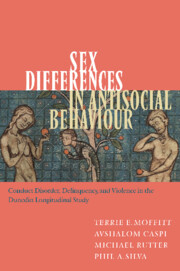 Sex Differences in Antisocial Behaviour
Sex Differences in Antisocial Behaviour Book contents
- Frontmatter
- Contents
- List of figures
- List of tables
- Preface
- Acknowledgements
- 1 Introduction
- 2 The Dunedin Multidisciplinary Health and Development Study
- 3 Sex differences in the amount of antisocial behaviour: dimensional measures
- 4 Sex differences in the prevalence of antisocial behaviour: categorical diagnostic measures
- 5 Sex differences in physical violence and sex similarities in partner abuse
- 6 Sex and the developmental stability of antisocial behaviour
- 7 Sex and the age of onset of delinquency and conduct disorder
- 8 Sex effects in risk predictors for antisocial behaviour: are males more vulnerable than females to risk factors for antisocial behaviour?
- 9 Sex effects in risk predictors for antisocial behaviour: are males exposed to more risk factors for antisocial behaviour?
- 10 Can sex differences in personality traits help to explain sex differences in antisocial behaviour?
- 11 Sex and comorbidity: are there sex differences in the co-occurrence of conduct disorder and other disorders?
- 12 Do girls who develop antisocial behaviour surmount a higher threshold of risk than their male counterparts?
- 13 Sex differences in the effects of antisocial behaviour on young adult outcomes
- 14 Sex, antisocial behaviour, and mating: mate selection and early childbearing
- 15 Evaluating the recommendation to relax the criteria for diagnosing conduct disorder in girls
- 16 Life-course persistent and adolescence-limited antisocial behaviour among males and females
- 17 Priorities for a research agenda
- References
- Index
4 - Sex differences in the prevalence of antisocial behaviour: categorical diagnostic measures
Published online by Cambridge University Press: 22 September 2009
- Frontmatter
- Contents
- List of figures
- List of tables
- Preface
- Acknowledgements
- 1 Introduction
- 2 The Dunedin Multidisciplinary Health and Development Study
- 3 Sex differences in the amount of antisocial behaviour: dimensional measures
- 4 Sex differences in the prevalence of antisocial behaviour: categorical diagnostic measures
- 5 Sex differences in physical violence and sex similarities in partner abuse
- 6 Sex and the developmental stability of antisocial behaviour
- 7 Sex and the age of onset of delinquency and conduct disorder
- 8 Sex effects in risk predictors for antisocial behaviour: are males more vulnerable than females to risk factors for antisocial behaviour?
- 9 Sex effects in risk predictors for antisocial behaviour: are males exposed to more risk factors for antisocial behaviour?
- 10 Can sex differences in personality traits help to explain sex differences in antisocial behaviour?
- 11 Sex and comorbidity: are there sex differences in the co-occurrence of conduct disorder and other disorders?
- 12 Do girls who develop antisocial behaviour surmount a higher threshold of risk than their male counterparts?
- 13 Sex differences in the effects of antisocial behaviour on young adult outcomes
- 14 Sex, antisocial behaviour, and mating: mate selection and early childbearing
- 15 Evaluating the recommendation to relax the criteria for diagnosing conduct disorder in girls
- 16 Life-course persistent and adolescence-limited antisocial behaviour among males and females
- 17 Priorities for a research agenda
- References
- Index
Summary
Chapter 3 revealed that more males than females engage in antisocial behaviours, and males engage in more antisocial behaviours than females. It also revealed that males' antisocial behaviours relative to females' were more likely to be serious and committed persistently at a high rate. The possible exception was drug-and alcohol-related activities, on which girls resembled boys, especially near age 15. In contrast to the continuously distributed measures of antisocial behaviour examined in the previous chapter, this chapter compares the sexes on categorical measures: diagnoses of antisocial disorder. The criteria for a diagnosis of conduct disorder are intended to capture behaviours that are serious and committed persistently at a high rate. Behaviours related to drugs and alcohol are excluded from the criterion list. Therefore, we would expect to find sex differences in diagnoses that are as large as, if not larger than, the sex differences we saw in chapter 3's continuous measures of antisocial behaviours.
A review of the five epidemiological studies that reported DSM-III (American Psychiatric Association, 1980) diagnoses of childhood disorders concluded that across all five studies more boys than girls had conduct disorder, despite marked differences between studies in the age range of children studied, nationality, reporting sources, and procedures followed to convert the symptoms assessed into diagnostic categories (Costello, 1989). Epidemiological studies conducted using DSM-III-R (American Psychiatric Association, 1987) and ICD-10 definitions in the 1990s agree (Lahey et al., 2000; Lewinsohn et al., 1993; Offord et al., 1996; Simonoff et al., 1997; Verhulst et al., 1997).
- Type
- Chapter
- Information
- Sex Differences in Antisocial BehaviourConduct Disorder, Delinquency, and Violence in the Dunedin Longitudinal Study, pp. 38 - 52Publisher: Cambridge University PressPrint publication year: 2001
- 1
- Cited by
